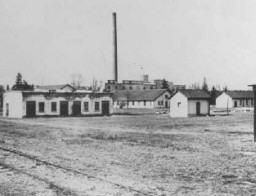You searched for: used%E4%BC%97%E7%AD%B9%E7%90%86%E8%B4%A2%E9%A1%B9%E7%9B%AE%E5%AE%9A%E5%88%B6%E5%BC%80%E5%8F%91%E3%80%90tg%EF%BF%BD%EF%BF%BD%EF%BF%BD%EF%BF%BD%EF%BF%BD%EF%BF%BD%EF%BF%BD%EF%BF%BD%EF%BF%BD%40ek7676%E3%80%91%E5%B9%B3%E5%8F%B0%E5%8C%85%E7%BD%91%E6%90%AD%E5%BB%BAust%E4%BC%97%E7%AD%B9%E7%90%86%E8%B4%A2%E9%A1%B9%E7%9B%AE%E5%AE%9A%E5%88%B6%E5%BC%80%E5%8F%91%E3%80%90tg%EF%BF%BD%EF%BF%BD%EF%BF%BD%EF%BF%BD%EF%BF%BD%EF%BF%BD%EF%BF%BD%EF%BF%BD%EF%BF%BD%40ek7676%E3%80%91%E5%B9%B3%E5%8F%B0%E5%8C%85%E7%BD%91%E6%90%AD%E5%BB%BAgnogu7gctt
<< Previous | Displaying results 301-350 of 1832 for "used%E4%BC%97%E7%AD%B9%E7%90%86%E8%B4%A2%E9%A1%B9%E7%9B%AE%E5%AE%9A%E5%88%B6%E5%BC%80%E5%8F%91%E3%80%90tg%EF%BF%BD%EF%BF%BD%EF%BF%BD%EF%BF%BD%EF%BF%BD%EF%BF%BD%EF%BF%BD%EF%BF%BD%EF%BF%BD%40ek7676%E3%80%91%E5%B9%B3%E5%8F%B0%E5%8C%85%E7%BD%91%E6%90%AD%E5%BB%BAust%E4%BC%97%E7%AD%B9%E7%90%86%E8%B4%A2%E9%A1%B9%E7%9B%AE%E5%AE%9A%E5%88%B6%E5%BC%80%E5%8F%91%E3%80%90tg%EF%BF%BD%EF%BF%BD%EF%BF%BD%EF%BF%BD%EF%BF%BD%EF%BF%BD%EF%BF%BD%EF%BF%BD%EF%BF%BD%40ek7676%E3%80%91%E5%B9%B3%E5%8F%B0%E5%8C%85%E7%BD%91%E6%90%AD%E5%BB%BAgnogu7gctt" | Next >>
-
Survivors in Buchenwald just after liberation
PhotoSurvivors in Buchenwald just after liberation. Troops of the US 6th Armored Division entered Buchenwald on April 11, and troops of the 80th Infantry arrived on April 12. Buchenwald, Germany, photograph taken ca. April 11, 1945.
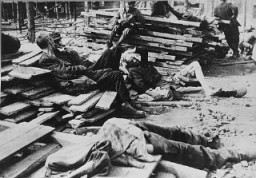
-
Insignia of the 86th Infantry Division
PhotoInsignia of the 86th Infantry Division. The 86th Infantry Division developed the blackhawk as its insignia during World War I, to honor the Native American warrior of that name who fought the US Army in Illinois and Wisconsin during the early nineteenth century. The nickname "The Blackhawks" or "Blackhawk" division is derived from the insignia.
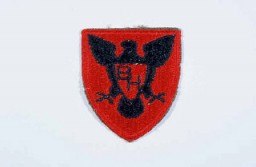
-
Insignia of the 9th Armored Division
PhotoInsignia of the 9th Armored Division. Although no nickname for the 9th was in common usage throughout World War II, "Phantom" division was sometimes used in 1945. It originated during the Battle of the Bulge, when the 9th Armored Division seemed, like a phantom, to be everywhere along the front.
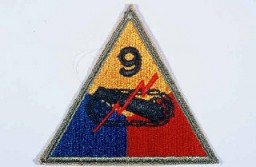
-
Insignia of the 45th Infantry Division
PhotoInsignia of the 45th Infantry Division. The 45th Infantry Division gained its nickname, "Thunderbird" division, from the gold thunderbird. This Native American symbol became the division's insignia in 1939. It replaced another previously used Native American symbol, a swastika, that was withdrawn when it became closely associated with the Nazi Party.
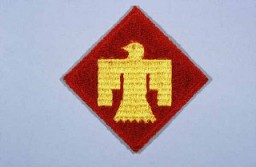
-
Dachau trial mess card
ArtifactEntry pass to a US military dining hall at Dachau, Germany. This card was issued to Anton Litwin, a member of the War Crimes Branch.
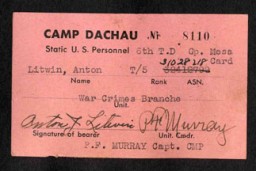
-
Eisenhower views corpses
PhotoGeneral Dwight D. Eisenhower (center, right) views the corpses of victims of the Ohrdruf camp. Germany, April 12, 1945.
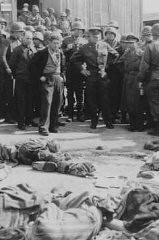
-
Victims of the Gardelegen atrocity
PhotoAmerican soldiers look at the exhumed bodies of prisoners who were burned alive in a barn outside Gardelegen. Germany, April 14-18, 1945.

-
Survivors of the Buchenwald camp
PhotoSurvivors of the Buchenwald concentration camp gather around trucks carrying American troops. Germany, May 1945.
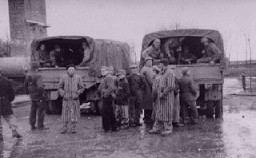
-
Art and Survival: György Beifeld's Visual Memoir from the Russian Front, 1942–1943
ArticleGyörgy Beifeld, a Jewish conscript in the Hungarian army, created a visual memoir of his experiences on the eastern front in 1942–1943 as a member of a forced-labor battalion .

-
Law on the Head of State of the German Reich
ArticleThe Law on the Head of State of the German Reich was the last step in destroying democracy in interwar Germany and making Adolf Hitler a dictator. Learn more.
-
Nazi Persecution of Jehovah's Witnesses
ArticleJehovah's Witnesses were subjected to intense persecution under the Nazi regime. Read more to learn why and how the Nazi regime targeted them.

-
Aliyah Bet
ArticleLearn more about Aliyah Bet, the clandestine immigration of Jews to Palestine between 1920 and 1948, when Great Britain controlled the area.

-
Persecution of Roma (Gypsies) in Prewar Germany, 1933–1939
ArticleBeginning in 1933, the Nazis persecuted Roma (often pejoratively called “Gypsies”) based on underlying prejudices and racism. Learn how this harassment escalated to genocide.

-
Eisenhower views burned remains of inmates
PhotoGeneral Dwight D. Eisenhower (third from left) views the charred remains of inmates of the Ohrdruf camp. Ohrdruf, Germany, April 12, 1945.
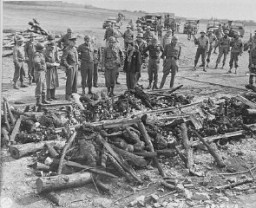
-
Insignia of the 2nd Infantry Division
PhotoInsignia of the 2nd Infantry Division. The nickname of the 2nd Infantry Division, "Indianhead," was derived from its World War I insignia. This insignia was developed from an emblem a truck driver in the division had painted on his truck.

-
Insignia of the 4th Infantry Division
PhotoInsignia of the 4th Infantry Division. The 4th Infantry Division's nickname, the "Ivy" division, is derived from the divisional insignia developed during World War I: four ivy leaves on a diamond field, symbolizing the roman numeral "IV."

-
Insignia of the 6th Armored Division
PhotoInsignia of the 6th Armored Division. "Super Sixth" became the nickname of the 6th Armored Division while the division was training in the United States, apparently to symbolize the division's spirit.
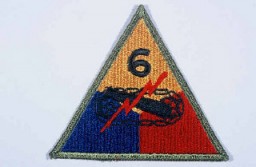
-
Insignia of the 26th Infantry Division
PhotoInsignia of the 26th Infantry Division. The 26th Infantry Division, the "Yankee" division, was so nicknamed to recognize the six New England states from whose National Guard units the division was raised during World War I.
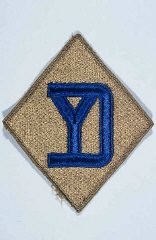
-
Insignia of the 10th Armored Division
PhotoInsignia of the 10th Armored Division. The "Tiger Division" nickname of the 10th originates from a division-wide contest held while it was training in the United States, symbolizing the division "clawing and mauling" its way through the enemy.
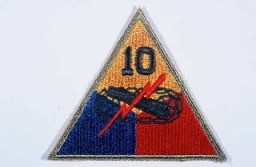
-
View of the Wöbbelin concentration camp
PhotoOn May 2, 1945, the 8th Infantry Division and the 82nd Airborne Division encountered the Wöbbelin concentration camp. Here, American soldiers patrol the perimeter of the camp. Germany, May 4-May 10, 1945.

-
Insignia of the 104th Infantry Division
PhotoInsignia of the 104th Infantry Division. The nickname of the 104th Infantry Division, "Timberwolf," originated from the division's insignia, a gray timberwolf. The timberwolf, native to the Pacific Northwest, was chosen as representative of the area where the division was formed in 1942.
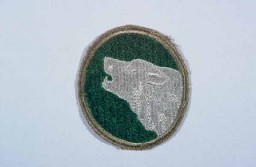
-
Aftermath of the Gardelegen atrocity
PhotoAn American tank follows German civilians from Gardelegen who are marching to a barn just outside the town, where they will dig graves for over 1,000 prisoners killed by the SS inside the barn. April 18, 1945.
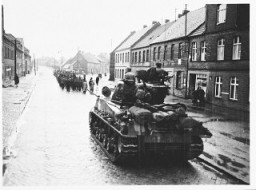
-
Insignia of the 3rd Armored Division
PhotoInsignia of the 3rd Armored Division. "Spearhead" was adopted as the nickname of the 3rd Armored Division in recognition of the division's role as the "spearhead" of many attacks during the liberation of France in 1944.

-
Insignia of the 69th Infantry Division
PhotoInsignia of the 69th Infantry Division. The 69th Infantry Division gained the nickname the "Fighting 69th" during World War II. The name has no heraldic significance, but simply conveys the esprit de corps of the division.
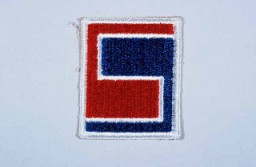
-
Insignia of the 71st Infantry Division
PhotoInsignia of the 71st Infantry Division. The nickname of the 71st Infantry Division, the "Red Circle" division, is based upon the divisional insignia (which includes a red circle).
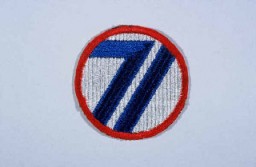
-
Insignia of the 12th Armored Division
PhotoInsignia of the 12th Armored Division. "Hellcats, " the winning entry in a division contest for a nickname held in early in 1943, symbolized the 12th's toughness and readiness for combat.
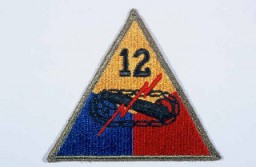
-
"What shall be done with the war criminals?"
ArtifactCover of booklet titled "What Shall Be Done with the War Criminals?" Published by the United States Armed Forces Institute, this was one of a series of 42 pamphlets created by the U.S. War Department under the series title "G.I. Roundtable." From 1943-1945, these pamphlets were created to "increase the effectiveness of the soldiers and officers and fighters during the war and as citizens after the war." Many of the pamphlets addressed the possibilities of a postwar world.

-
General Dwight D. Eisenhower views the Ohrdruf camp
PhotoGeneral Dwight D. Eisenhower (center), Supreme Allied Commander, views the corpses of inmates who died at the Ohrdruf camp. Ohrdruf, Germany, April 12, 1945.

-
Insignia of the 1st Infantry Division
PhotoInsignia of the 1st Infantry Division. The 1st Infantry Division's nickname, the "Big Red One," originated from the division's insignia, a large red number "1" on a khaki field. This nickname was adopted during World War I, when the 1st was the first American division to arrive in France.
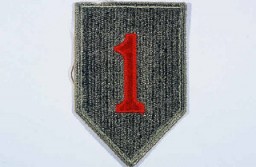
-
Insignia of the 14th Armored Division
PhotoInsignia of the 14th Armored Division. Although lacking a nickname during the war, the 14th became known as the "Liberators" soon afterward to signify its accomplishments in liberating hundreds of thousands of forced and slave laborers, concentration camp prisoners, and Allied prisoners of war in 1945.
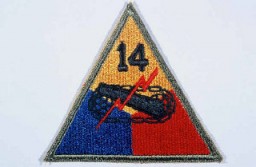
-
Insignia of the 84th Infantry Division
PhotoInsignia of the 84th Infantry Division. The 84th Infantry Division derives its nickname, "Railsplitter" division, from the divisional insignia, an ax splitting a rail. This design was created during World War I, when the division was known as the "Lincoln" division to represent the states that supplied soldiers for the division: Illinois, Indiana, and Kentucky. All figured prominently in the life of President Abraham Lincoln, of log-splitting legend.
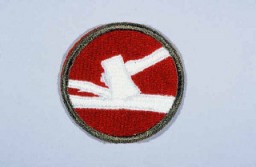
-
Insignia of the 90th Infantry Division
PhotoInsignia of the 90th Infantry Division. Called the "Tough Ombres," the 90th Infantry Division was raised from draftees from the states of Texas and Oklahoma during World War I. The divisional insignia incorporates the letters "T" and "O" to symbolize both states. These letters later yielded the nickname "Tough Ombres," symbolizing the esprit de corps of the unit. The 90th was also sometimes called the "Alamo" division during World War II.

-
Insignia of the 83rd Infantry Division
PhotoInsignia of the 83rd Infantry Division. The 83rd Infantry Division received its nickname, the "Thunderbolt" division, after a division-wide contest for a new nickname held in early 1945. The earlier nickname, "Ohio," was based on the division's insignia (which includes the name "Ohio," where the division was raised during World War I). A new nickname was desired to represent the nationwide origins of the division's personnel during World War II.
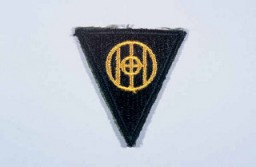
-
Insignia of the 95th Infantry Division
PhotoInsignia of the 95th Infantry Division. The 95th Infantry Division, the "Victory" division, gained its nickname from the divisional insignia approved in 1942: the arabic numeral "9" combined with the roman numeral "V" to represent "95." The "V" led to the nickname, since the letter "V" was universally recognized as an Allied symbol for resistance and victory over the Axis during World War II.
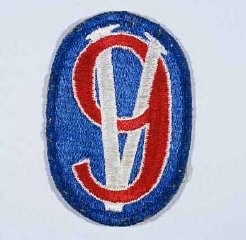
-
Insignia of the 8th Armored Division
PhotoInsignia of the 8th Armored Division. The nickname of the 8th Armored Division, the "Thundering Herd," was coined before the division went to Europe in late 1944. It was also known as the "Iron Snake" late in the war, after a correspondent for Newsweek likened the 8th to a "great ironclad snake" as it crossed the Rhine River in late March 1945.
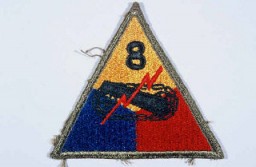
-
Insignia of the 8th Infantry Division
PhotoInsignia of the 8th Infantry Division. The 8th Infantry Division was known as both the "Golden Arrow" and "Pathfinder" division during World War II. Both nicknames originated from the division's insignia, which includes a gold arrow to represent the nineteenth century explorer of California, John Fremont. The division was formed in California in 1918.

-
Insignia of the 101st Airborne Division
PhotoInsignia of the 101st Airborne Division. The nickname of the 101st Airborne Division, "Screaming Eagles," originates from the division's insignia, a bald eagle on a black shield. "Old Abe" was the eagle mascot of a Wisconsin regiment during the Civil War. The 101st was formed as a reserve unit in Wisconsin shortly after World War I and included "Old Abe" as part of the division's insignia.
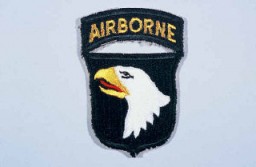
-
Insignia of the 103rd Infantry Division
PhotoInsignia of the 103rd Infantry Division. The 103rd Infantry Division, the "Cactus" division, is so called after the 103rd's shoulder patch, a cactus in a gold circle. The cactus is representative of the states whose troops formed the unit in the early 1920s: Arizona, Colorado, and New Mexico.
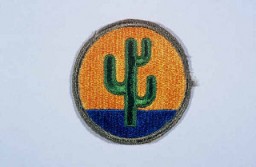
-
Insignia of the 63rd Infantry Division
PhotoInsignia of the 63rd Infantry Division. The 63rd Infantry Division was nicknamed the "Blood and Fire" division soon after its formation in the spring of 1943. The nickname commemorates British prime minister Winston Churchill's statement at the Casablanca Conference in January 1943 that "the enemy would bleed and burn in expiation of their crimes against humanity." The divisional insignia illustrates the nickname.
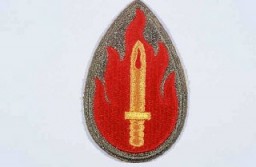
-
Insignia of the 42nd Infantry Division
PhotoInsignia of the 42nd Infantry Division. The nickname of the 42nd Infantry Division, the "Rainbow" division, reflects the composition of the division during World War I. The division was drawn from the National Guards of 26 states and the District of Columbia. It represented a cross section of the American people, as the rainbow represents a cross section of colors.

-
Insignia of the 36th Infantry Division
PhotoInsignia of the 36th Infantry Division. The 36th Infantry Division, the "Texas" division, was raised from National Guard units from Texas and Oklahoma during World War I. The "T" in the division's insignia represents Texas, the arrowhead Oklahoma. The division was also sometimes called the "Lone Star" division, again symbolizing its Texas roots.
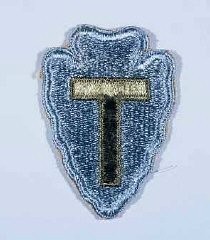
-
Insignia of the 29th Infantry Division
PhotoInsignia of the 29th Infantry Division. "Blue and Gray" was coined as the nickname of the 29th Infantry Division by the division's commander during World War I. The name commemorates the lineage of the mid-Atlantic states' National Guard units that formed the division, many with service on both sides during the Civil War.
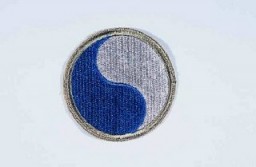
-
Death march victims
PhotoAn American soldier looks at the corpses of Polish, Russian, and Hungarian Jews found in the woods near Neunburg vorm Wald. The victims were prisoners from Flossenbürg who were shot near Neunburg while on a death march. Germany, April 29, 1945.
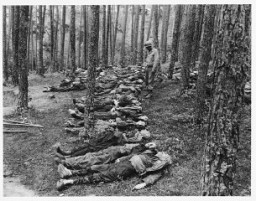
-
Insignia of the 89th Infantry Division
PhotoInsignia of the 89th Infantry Division. The 89th Infantry Division's nickname, the "Rolling W," is based on the division's insignia. Created during World War I, this insignia utilized a letter "M" inside a wheel. When the wheel turns, the "M" becomes a "W." The letters "MW" signify the mid-west origin of the troops who formed the 89th during World War I. The division was also known as the "Middle West" division, another variation on its origin.

-
Insignia of the 99th Infantry Division
PhotoInsignia of the 99th Infantry Division. The 99th Infantry Division, the "Checkerboard" division, gained its nickname from the division's insignia. The insignia was devised upon the 99th's formation in 1942, when the division was headquartered in the city of Pittsburgh. The blue and white checkerboard in the division's insignia is taken from the coat of arms of William Pitt, for whom Pittsburgh is named. The division was also known as the "Battle Babies" during 1945, a sobriquet coined by a United Press…
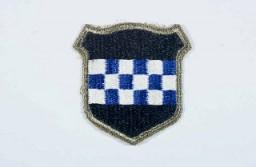
-
The Riegner Telegram
ArticleThe Riegner telegram detailed the Nazi plan to systematically murder European Jews. It was sent to the British and American governments in August 1942.
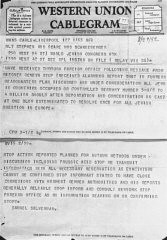
-
Coining a Word and Championing a Cause: The Story of Raphael Lemkin
ArticlePolish-Jewish lawyer Raphael Lemkin introduced the word genocide in 1944 and lobbied tirelessly for its addition as a crime in international law.
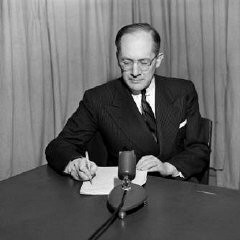
-
UN Convention on the Prevention and Punishment of Genocide
Timeline EventJanuary 12, 1951. On this date, the United Nations Convention on the Prevention and Punishment of Genocide entered into force.
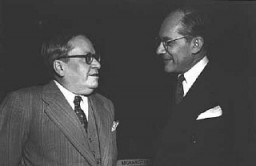
-
Raphael Lemkin Dies
Timeline EventAugust 28, 1959. On this date, Raphael Lemkin died. He coined the term "genocide" and worked tirelessly for the term to become international law.

-
Establishment of Dachau Camp
Timeline EventMarch 22, 1933. On this date, the SS established the Dachau concentration camp in Germany.
